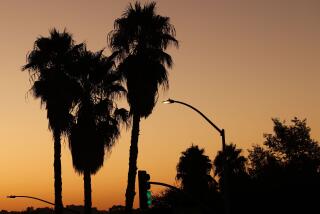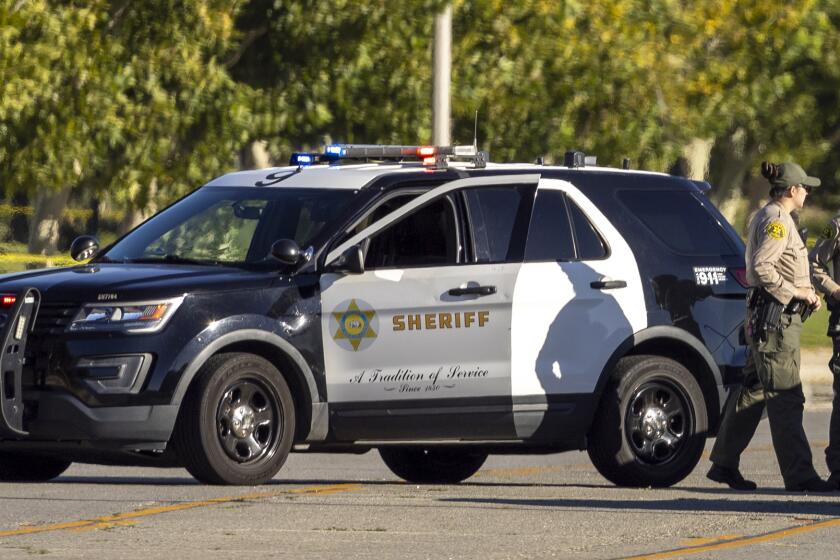Sizzling in the Sun
- Share via
PACOIMA — As the sun sizzled against the aluminum siding of her trailer, Maria Rosales sat at the kitchen table and tried to enjoy her lunch of chicken and rice. Beads of sweat trickled down her face too fast for her to catch with the small towelette she held tightly in her hand, while flies big and small flew around her florid face.
Finally, her appetite gone, she gave up and put the plate in the freezer.
“Outside it’s bad. But in here, it’s unbearable,” said Rosales, 41. “I can’t even concentrate on my problems, lately. I just keep thinking: This is too much heat. Oh my God, this is too much heat.”
A few yards away at trailer No. 7, Caroline Grimaldi and her son Adam, 8, emptied the Christmas ornaments from a storage bin, filled the big green tub with water and converted it into a mini-pool. The tub was too tiny for Adam to dunk his head underwater, so he sprayed himself in the face with the hose.
“How do we keep cool? Well, we improvise,” said Grimaldi, a former nurse turned street minister at the Pacoima Trailer Park on San Fernando Road. “We fill big trash barrels with water. We take siestas. We all look out for each other.”
For those with air conditioning in their homes or offices, surviving the record-setting summer heat means flipping a switch. But for Rosales, Grimaldi and other poor families living on incomes so modest that even a fan is a luxury, coping with the heat makes daily life even more of a struggle.
Lacking the money for curtains, Rosales blocks the sun from her trailer by draping thick towels and blankets over the windows. Though she owns a fan, she keeps it turned off because she fears her 2-year-old daughter Jasmine may get her fingers caught in its blades. In addition, along with the heat have come a slew of roaches that have infested almost every corner of the trailer she shares with her four children.
“Some days I can’t take it,” said Rosales, who moved into the trailer after a former lover burned down her house in 1986. She now works part-time as a printer’s assistant in Sylmar. “I feel so much stress and this just adds to it.”
Relief is nowhere in sight. After sweating through the third-warmest August on record, September rolled in with the same defiance. Temperatures on Wednesday hit a high of 106 in Chatsworth and 101 in Burbank, but meteorologist Gary Ryan said the Valley probably seemed hotter because of higher-than-normal humidity. On Wednesday, Valley humidity averaged about 40%.
“The subtropical weather we’re having now is more reminiscent of Miami than Los Angeles,” Ryan said, adding that the warm, sticky weather is likely to continue today with a 40% chance of showers through Friday.
Acting Los Angeles Mayor Joel Wachs issued a directive Wednesday calling for extra vigilance in warding off a wave of heat-related illnesses. He also called on city residents to check on friends and neighbors, particularly those who are elderly and most vulnerable to the heat.
“L.A. is now undergoing one of the most serious heat waves in recent memory and it’s reaching a critical stage,” Wachs said.
Wachs, a councilman who is filling in for Richard Riordan while the mayor vacations, has asked police, housing officials, mail carriers, meter readers and social workers to be on the watch for problems among elderly, ill and disabled people, particularly those living alone.
Wachs also asked the city’s Department of Water and Power to take measures to ensure power for those in the department’s “lifeline” program, which provides low-cost electricity to the poor.
If the heat wave continues, Wachs said, he will ask air-conditioned city recreation centers and libraries to remain open longer.
Program coordinator John Horn said the steamy weather has brought more families living on the streets or in crowded houses to the Pacoima Service Center in search of emergency shelter.
“We can tell they’re suffering the effects as soon as they walk in because they’re more irritable and frustrated,” Horn said.
Homeless families, Horn said, are more difficult to place than individuals. There are only two shelters in the Valley that accept families and both have long waiting lists, he said. On Wednesday, Horn finally found a temporary refuge from the heat for one desperate family--at a shelter in Upland.
Around the northeast Valley, where much of the Valley’s poverty is concentrated, people like Marcelino Vallejo, 72, hosed down the fronts of their homes with water, producing a makeshift cooler.
A few blocks away on Ilex Avenue in Pacoima, 80-year-old Dionicio Quinones relaxed under a canopy of leafy trees and vines and helped himself to a plate of sliced peaches and apples. Basking in the shade and bare-chested, Quinones explained how he grew a virtual forest around his house to provide shade from the sun’s rays.
“I have a small cooler inside, but at my age, fresh air is better for me than air conditioning,” he said.
Despite the blistering heat wave, the Los Angeles Unified School District has not called a “heat day,” which used to be a common summer occurrence when year-round schools were not yet air conditioned, said the district’s Pat Spencer.
But if high temperatures persist as September wears on, heat days may become common again, since some schools reopening for the fall still do not have air conditioning, Spencer said.
Officials generally call a “heat day” when the next day’s temperatures are predicted to rise over 100 degrees and a school is less than 50% air conditioned. On such days, students are sent home with a note that school will be closed the following day, Spencer said.
Valley College President Tyree Wieder said she had roughly 60 slips of paper on her desk from teachers reporting classrooms were so hot that it was difficult to lecture or learn.
A few teachers held class outside under trees, Wieder said, while others gave out assignments and quickly adjourned. Extra fans have been purchased, but they just blow the hot air around, she said.
Wieder is especially irritated by the heat wave because her campus was supposed to be air conditioned by this fall. The plans have been held up in the state architect’s office for nine months.
At Pierce College in Woodland Hills, President E. Bing Inocencio shed his coat and tie for cooler casual shirts with rococo designs from his native country, the Philippines.
Inocencio gave teachers the option of dismissing classes early. Some canceled classes entirely.
“Last Tuesday one of our students fainted in class,” Inocencio said.
Times staff writers Jill Leovy, Abigail Goldman and Nancy Hill-Holtzman contributed to this story.
More to Read
Sign up for Essential California
The most important California stories and recommendations in your inbox every morning.
You may occasionally receive promotional content from the Los Angeles Times.













